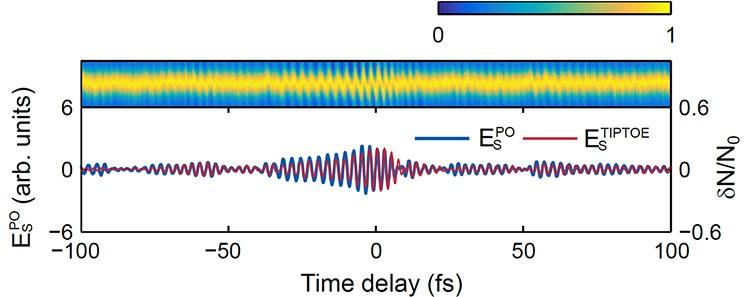May 21 2018
Scientists at the Center for Relativistic Laser Science, within the Institute for Basic Science (IBS), have devised a novel technique to determine the shape of laser pulses in ambient air.
 Figure 1: Schematic diagram of TIPTOE technology. Special mirrors divide a laser beam into a strong (EF) and a weak (ES) laser pulses. When the laser beams reach the air or gas-filled chamber, electrons “escape” from their atoms (tunnel ionization) and are caught by the metal plates. Changes in ionization are used to measure the shape of the laser pulse (Image credit: IBS)
Figure 1: Schematic diagram of TIPTOE technology. Special mirrors divide a laser beam into a strong (EF) and a weak (ES) laser pulses. When the laser beams reach the air or gas-filled chamber, electrons “escape” from their atoms (tunnel ionization) and are caught by the metal plates. Changes in ionization are used to measure the shape of the laser pulse (Image credit: IBS)
This patented technique is different from traditional strategies and eliminates the need for a vacuum environment. It can be applied to laser beams of varying wavelengths such as visible, UV, or longer. Presently available for technology transfer and commercialization, this patented method has now been reported in Optica, and it is anticipated to speed up studies on the interaction between light and matter.
Experts’ goal is to regulate the behavior of the electrons by using laser light, and possibly to exploit the electric currents. But, to achieve these objectives, the waveform of a laser pulse has to be known. Since molecular events take place in just attoseconds (1 as = 10-18 seconds), the current approach available to analyze them depends on the creation of attosecond X-ray pulses which needs detection equipment in vacuum chambers. Therefore, researchers at IBS developed an alternative method known as tunneling ionization with a perturbation for the time-domain observation of an electric field (TIPTOE), which does not require either vacuum conditions or X-rays pulses.
The TIPTOE method is based on two superimposed laser pulses—a weak one and a strong one. When molecules or atoms are exposed to strong electric fields, similar to the ones generated by powerful laser pulses, they may tend to lose some of their electrons in a phenomenon known as tunnel ionization. The TIPTOE technique relies both on the tunnel ionization of the electrons of the atoms present in the air and the intensity of the electric field. The intensity of the electric field varies by the time variations between the weak and the strong superimposed laser pulses.
Since a higher electric field intensity relates to higher ionization, variations in the electric field are reflected directly on the tunnel ionization and these variations in tunnel ionization, in turn, are utilized to determine the shape of the laser pulse. As tunneling ionization lasts just 200 attoseconds, the TIPTOE method can offer sufficient temporal resolution to determine different wavelength pules such as visible, UV, or longer.
To validate the TIPTOE method, IBS researchers compared it with the traditional X-ray pulse generation method, and the outcomes were the same.
“TIPTOE’s biggest advantage is the universality of this technique at different wavelengths,” explains the leading author of this study, Kyung Taec Kim.

Figure 2: Comparison between attosecond X-ray pulse method X-ray (blue) and TIPTOE (red) to validate the new technique developed by IBS scientists. The waveforms measured with TIPTOE match the ones obtained with the conventional method. (Credit: IBS)